Artist Interviews 2021
Gregg Chadwick 
By Laura Siebold
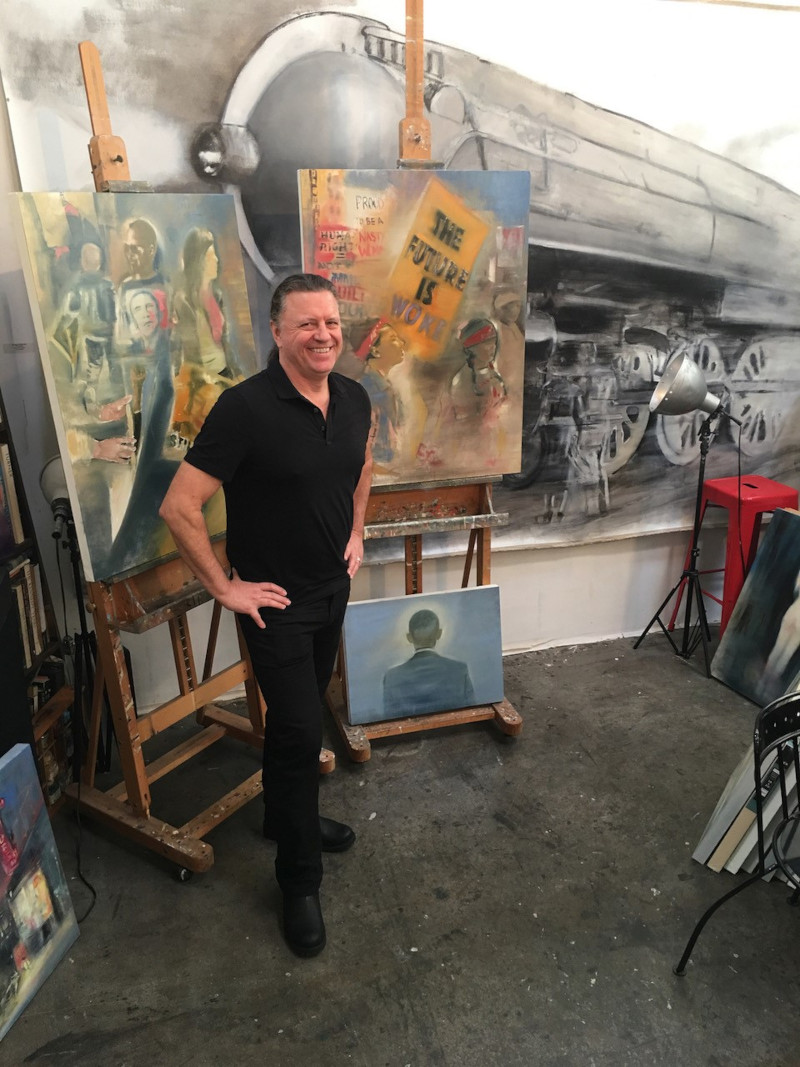
The Other Art Fair edition at the Barker Hangar in Santa Monica couldn’t have been a better place to give contemporary artist Gregg Chadwick a platform to exhibit his oil on linen paintings, especially as he creates his art in an old airplane hangar, as well.
Gregg takes inspiration from important cultural and political figures and turns them into paintings, capturing moments and moods of contemporary America. Gregg’s series are very distinct in character – ranging from strong portraits of human beings, animals in the natural world, over medical portraitures to paintings that are inspired by meditation. A common element of Gregg’s paintings is his use of “internal illumination” to hold the viewer’s attention, his layered “Pentimenti” painting technique, and his tendency to create a glimpse of a path into the unknown future, told by his paintings multifaceted stories. Often, the artist draws ideas from poetry, novels, and music, then incorporating those elements into his paintings. Being renowned for his expressive art, Chadwick has exhibited in various galleries and shows across the U.S. and internationally; his paintings are part of many permanent collections.
Gregg Chadwick is based in Los Angeles, California.
Many of your paintings capture some iconic moments of American cultural heritage. Which role do the concepts of culture, time, place/space, and humanity play in your paintings?
Often the big stories in my artwork are inspired by the rhythms and ideas found in music, literature, history, politics, and film. One of my collectors has described me as an artistic chronicler of our times.
He finds threads of current events and pop culture woven into the philosophical and spiritual undercurrents of my art. Three of my most recent paintings were inspired by powerful Black women making change in our world.
My recent portrait of Nikole Hannah – Jones was inspired by watching her keynote speech at a Zoom event sponsored by UCLA Health in February 2021. Nikole Hannah-Jones, a MacArthur Fellowship
and Pulitzer Prize winning investigative journalist known for her coverage of civil rights in the United States, captivated me throughout her lecture. I found myself creating thumbnail sketches for a future
painting as she spoke about the underreported stories of enslavement and injustice that are woven through the history of the United States. The finished painting, Nikole Hannah-Jones
(The Idea of America), as is often typical for my work, considers culture, time, place, and humanity as it captures a moment in contemporary America. In the portrait, as in the lecture
I witnessed, Nikole looks out from the surface and engages the viewer with an open presence. Behind and around Nikole swirl iconic elements of our shared history.
The now removed statue of Robert E. Lee from Richmond, Virginia is overlayed with a projection reading BLM (Black Lives Matter). The face of George Floyd beckons us to remember. And Nikole’s necklace lets us into her personal world of Black Girl Magic.
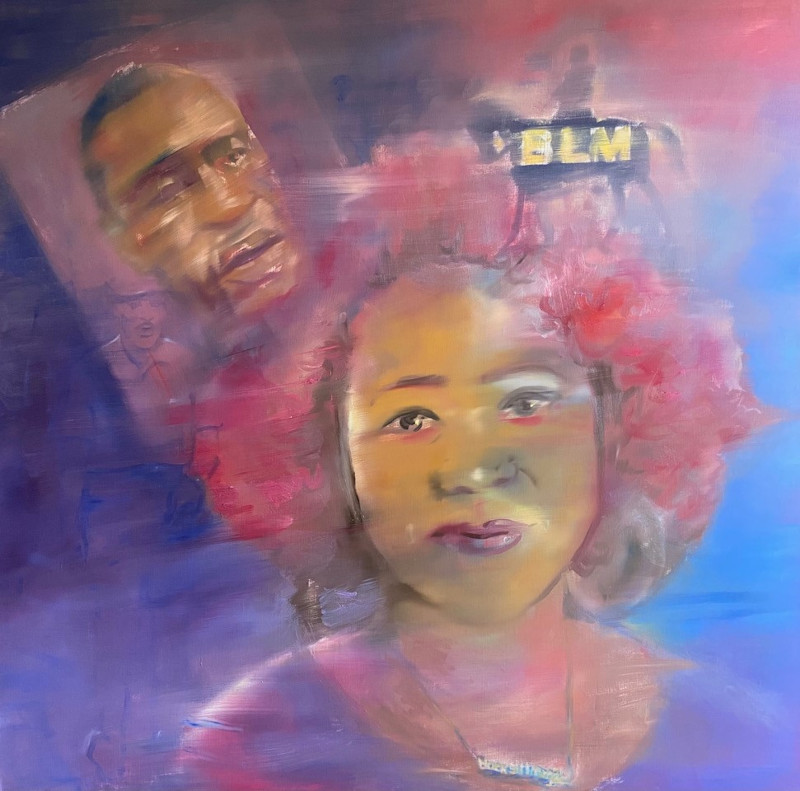
As a companion piece, I painted the musician H.E.R. performing America the Beautiful at the Super Bowl in February 2021. America the Beautiful was written as an aspirational
response to the bluster of The Star-Spangled Banner by feminist poet and Wellesley professor Katharine Lee Bates and published on the Fourth of July in 1895.
In my painting H.E.R. (The Idea of America), I envision H.E.R.’s liquid guitar solo filling the stadium and sonically asking the question: Can the United States live up to its grand ideals?
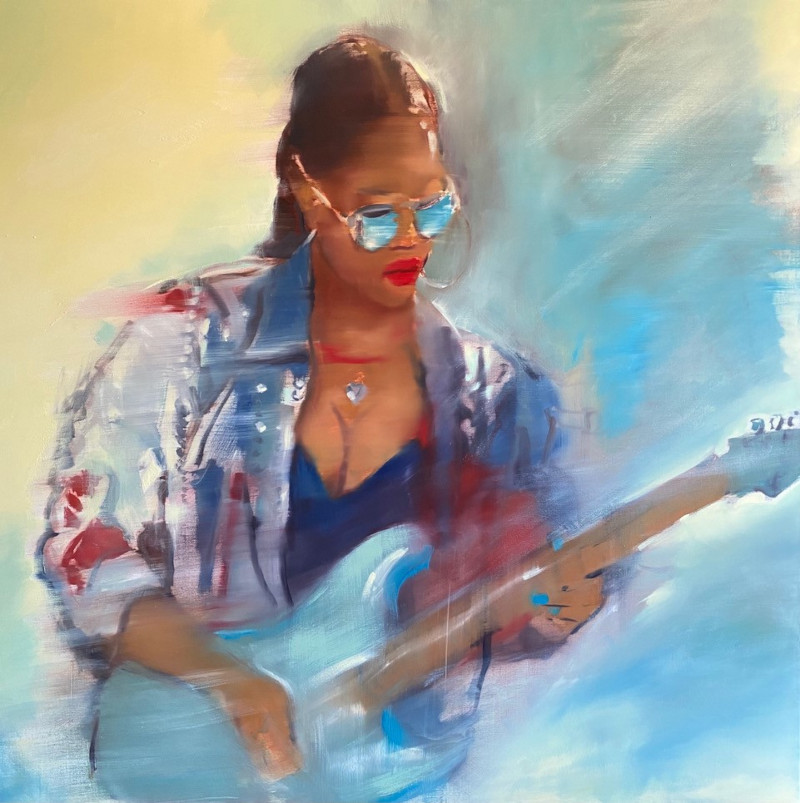
My oil on linen portraits of H.E.R. and Nikole Hannah-Jones were on exhibit at the 18th Street Arts Center during the exhibition Recovery Justice: Being Well which ran from March 8, 2021 – September 11, 2021. Link at: https://18thstreet.org/event/recovery-justice-being-well/
My third painting in the series, Kamala at Howard was inspired by Vice President Kamala Harris as an undergraduate at Howard University in Washington DC.
The images of Kamala as a member of the influential Alpha Kappa Alpha Sorority bring a smile to my face and inspired my painting. Coming from a family with a
Black father originally from Jamaica and a mother originally from India, Kamala is the first person of Asian and Black ancestry to be Vice President of the United States.
Having lived in San Francisco for a number of years, I was fortunate to be able to vote for Kamala in every one of her political races - from San Francisco District Attorney,
to California DA, to Senator from California, and now as Joe Biden's running mate. “I’m Speaking", Kamala said as she was interrupted at the VP Debate on October 7, 2020. I know that she will speak for all of us in her exciting future.
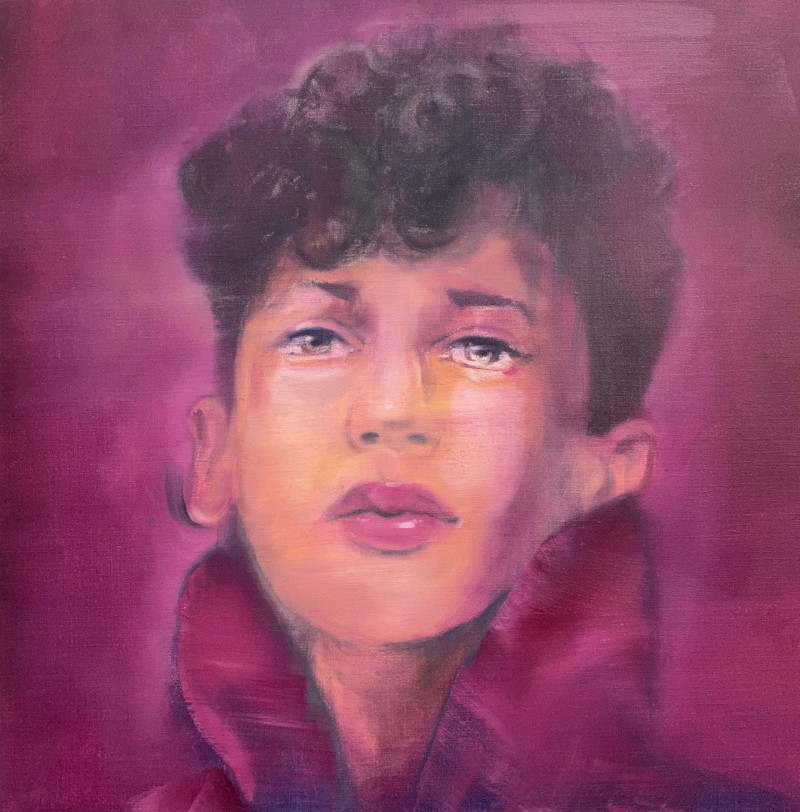
Kamala at Howard is currently exhibited in the online exhibition Art for Your Life on DotRed. Link at: https://dotred.co/gregg-chadwick-kamala-at-howard/.
Your series range from “Our Fragile Earth”, a series focused on the natural world, its beauty and fragility, over “History of Nursing”,
displayed at UCLA’s School of Nursing, to the culturally focused “The Idea of America”, to memories of time and place captured in “Mystery Train” and “City Lights”.
“The Saffron Road” with its meditative character has a very different approach, as well. Can you tell us a little about the intention behind each series? What fascinates you about transcendent colors and light?
I am currently working on a number of ongoing artistic bodies of work that look at the world around us and its historical underpinnings. A common thread that connects my themes is the role of light and movement in each painting. I aim for a sort of transcendence that harkens back to the past and points to a shared future of enlightenment. I remember the first time as a young artist that I stood in front of Titian’s Assumption of the Virgin in the Basilica dei Frari in Venice, Italy. The seemingly incandescent light that emerges from within Titian’s painting inspired me to open up my own paintings with internal illumination that draws in viewers and holds them in the spell of light.
In the next few paragraphs, I outline my current themes and the inspiration behind them.
Our Fragile Earth
I first became aware of the fragile nature of our planet as an elementary school student. For Christmas one year, I asked my parents for the book Wildlife in Danger published by the IUCN (International Union for the Conservation of Nature).
They are still an important organization providing information, plans, and hope for our endangered earth. Worried about the environment as a kid, I drew pictures of animals constantly.
Now I have brought out a series of paintings inspired by the 50th anniversary of Earth Day that shed light on climate change, the beauty of the natural world, and our place with other species.
History of Nursing
I was commissioned by the UCLA School of Nursing to create what Dean Linda Sarna described as “Ten amazing paintings evoking different aspects of nursing and the school's history which enhance the environment of the School of Nursing where we work,
teach, study, explore, and create.” In these difficult years of COVID-19, healthcare workers stand on the frontlines, fighting for our collective well-being. I continue to create artworks about nursing, hospitals,
and the health professions as a thank you to the nurses, physicians, and hospital workers that care for us.
The Idea of America
Art at its best possesses an uncanny ability to communicate ideas and feelings that we need to understand. It seems that especially in times of struggle or unrest,
art helps us connect to the personhood of others. Art creates dialogue. Dialogue promotes reflective discussion. And reflection can lead to change. My paintings in
The Idea of America are crafted as reflecting devices that mirror and focus the viewer’s attention on where we've been, and where we are going in the United States.
As Marvin Gaye sang so poignantly - “What’s going on.”
Mystery Train
I grew up with the rails of America in my blood. My grandfather Arthur Desch, worked as a fireman stoking coal in steam engines before he advanced to train engineer on the
Jersey Central Line. Parties and family gatherings in my grandparent’s home brought the rhythms of the rails home. In their clean but Jersey dank basement, the sounds of
railroad workers echoed in the music my aunts and cousins played in the shadows of the train lines outside. From Junior Parker, to Elvis Presley, to Bob Dylan, to Johnny
Cash, to The Band, to Bruce Springsteen, to Michael McDermott, to arts writer Greil Marcus, to film writer and director Jim Jarmusch, the enduring mythos of America and its
legacy has been wrapped in the blues notes of the song Mystery Train. Recently, while flipping through my mom’s carefully tended scrapbook, I found black and white memories
of my family’s yearnings, struggles, and triumphs. My current series of paintings is steeped in these powerful echoes of those machine days.
City Lights
For me, walking in a city is one of life's greatest treasures. Over the years, I have created art influenced by my urban treks in cities across the globe.
Los Angeles, New York, San Francisco, Chicago, Paris, Venice, Verona, Berlin, Amsterdam, Tokyo, and Kyoto have found their place in my artwork and continue to inspire new paintings built upon my memories of time and place.
The Saffron Road
Twenty years ago in Thailand, I woke up at dawn and spent the morning quietly and carefully observing the saffron robed monks on their morning pilgrimages. On my return
to the U.S. later that week, I began to paint Buddhist monks, privately at first - as a form of meditation. Only later did I grasp the dharmic sense of responsibility
inherit in this new body of work. I needed to paint these paintings. And I found that the audience I had developed over the years felt the need to see them also.
They have given me their trust that I will create paintings that speak of our times but also provide clues to a future path into the unknown.
When did you first start using the “Pentimenti” technique? Can you summarize what this technique entails and explain why you made it a part of your signature style?
Linseed oil has the propensity to grow more transparent with age and visible traces of earlier painted marks gradually appear because of this tendency — called pentimenti. I embrace this eventual outcome in my work and incorporate planned and unplanned pentimenti in my process. I first started using this technique as a graduate art student while taking part in New York University’s program in Venice, Italy. The subtle paint layers in the artworks of Renaissance painters Bellini, Giorgione, Titian and Tintoretto inspired me to take advantage of the transparent nature of oil paint and to play with its effects in my own paintings. I began to allow ghosts of earlier ideas to remain within my artworks and combine with other transparent moments to create a semblance of movement, of time passing. While visiting the museums and libraries in Italy, I also learned that in antiquity and later during the Middle Ages, manuscript pages made from animal hides were often scraped down and used again and again. Faint traces of the underwritings on these parchments, called palimpsests, survived. My painting process involves a series of applications and erasures, echoing these layered fragments from the past. At times, I scrape down entire wet paintings leaving a fragile palimpsest. These under images often bring forth mysterious fragments from my subconscious. As illustrated in my oil on linen painting New York State of Mind (Platform), I build a combination of shadow and illumination to create a sensation of light emanating from the work as well as the feel of a crowd moving across an elevated subway platform.
By layering paint upon paint, I construct an artwork through a succession of present moments in time that often combine in unforeseen patterns. A viewer remarked that my paintings resemble "time travel where the molecules are not quite sure where they belong." This visual conundrum plays with the proposition of many quantum physicists that time may not exist at the most fundamental level of physical reality.
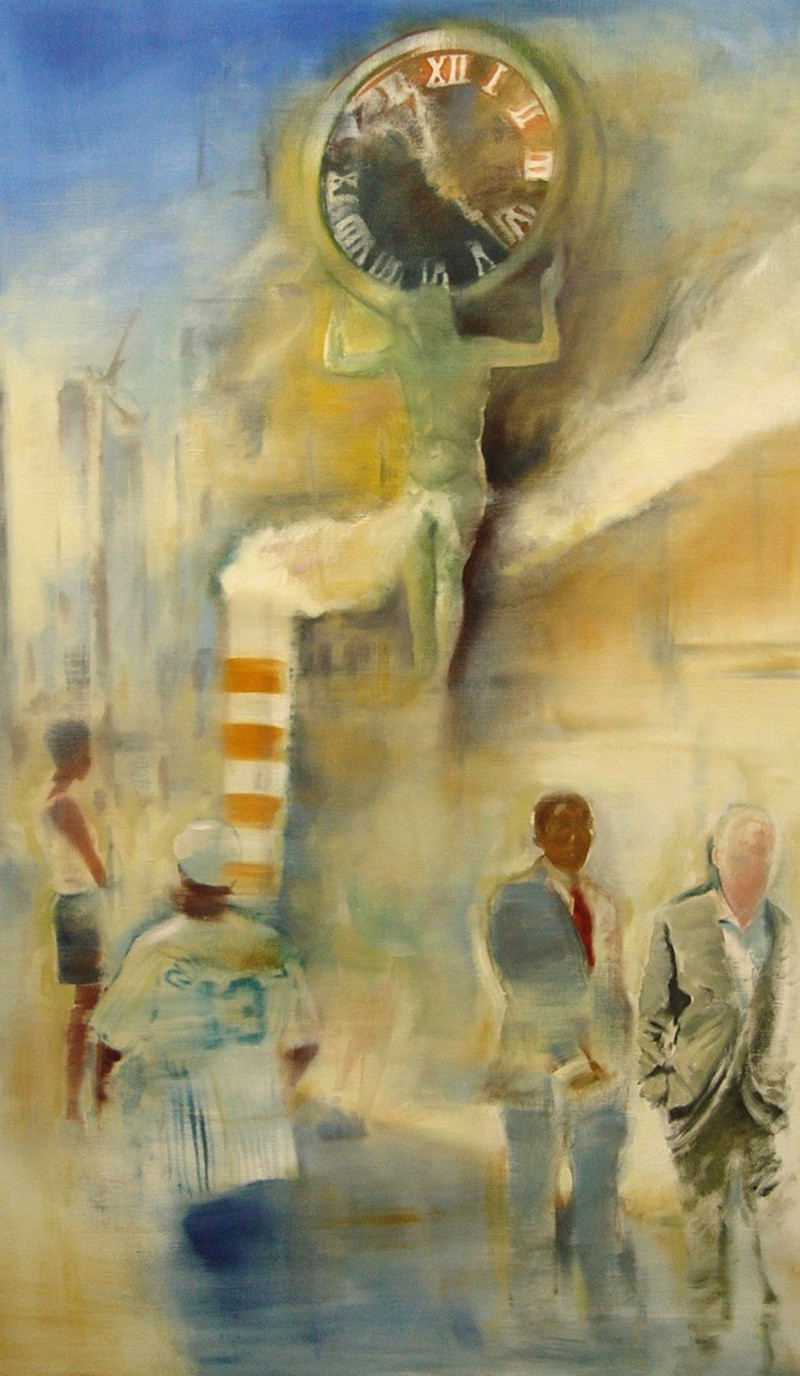
The longer the viewer looks at your paintings, the more details become apparent and, by recognizing your paintings’ intricately linked layers, the deeper the viewer understands the artwork. What do you want your viewers to take away from your art?
When viewed up close, my paintings reveal the process beneath the image. A sweep of paint can create a sensation of light as well as a compositional link across the surface of the painting.
In my most recent elephant inspired artwork The Greatest of Wanderers, a brush laden with savannah yellow oil paint evokes movement along the flank of the great animal. Patches of sky blue and
russet tones bounce across the grand elephant’s head. All of these shades also find their place in the landscape, knitting the painting’s surface together in a quilt of color.
The elephant in The Greatest of Wanderers is intricately tied into its environment in the way the artwork is painted and in the subject matter itself. The Greatest of Wanderers was
inspired by the efforts of the Sheldrick Trust as they strive to create a world that believes all elephants deserve to roam wild and free, safe from harm. My painting reflects these
efforts and creates a painterly description of an interconnected world. The linked layers within my paintings can lead to implied narratives, imagined stories, and new ideas.
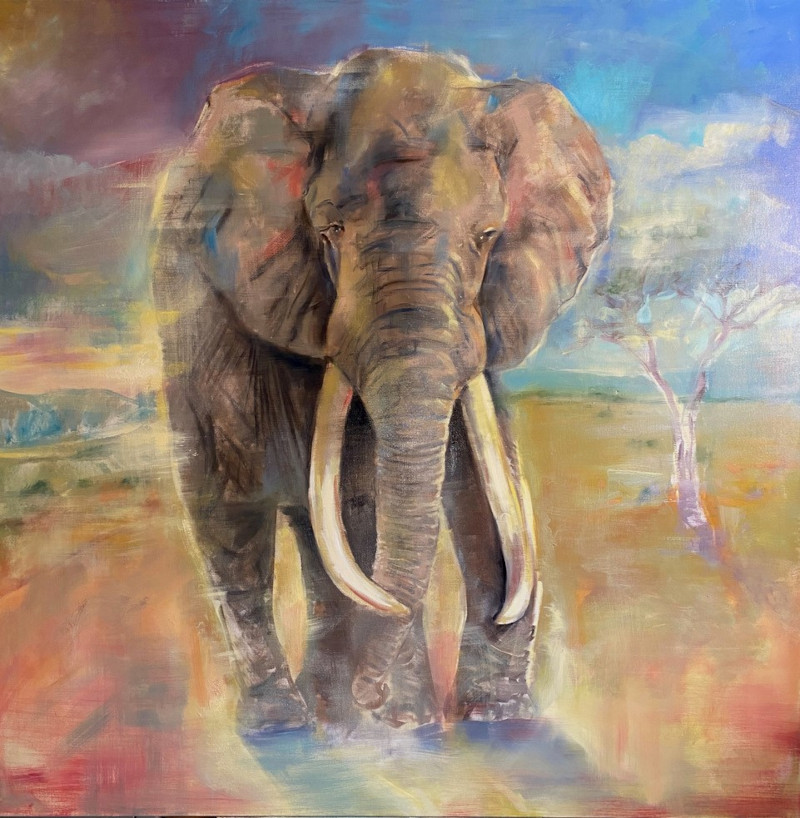
If you follow Peter Clothier’s advice, as stated on your website, viewers are prompted to read your paintings like poetry. How do you create meaning and offer the viewer new ideas by painting?
As Peter Clothier suggests, my love of verse has helped me create paintings that the viewer can read as poetry. Often a poem will stack images together that creates tension or encourages a thought process that is due to the sum of its images. My painting New York Minute uses a similar technique with its mix of clock, figures, and city street. Smoke from an orange and white construction vent knits the painting together like a pause or space in a poem. Time hangs over the artwork with an almost audible tick, tick, tick of the clock.
Poetry has inspired me since I was a young artist. While in High School in the Washington DC suburbs, I would often venture into the city for art classes at the Corcoran School of Art
and my own self-guided education at the incredible art museums in Washington DC. My painting As If the Suburban Sky was inspired by Picasso’s paintings of acrobats now in the National
Gallery and the poem Fifth Duino Elegy that Rainer Maria Rilke wrote while inspired by Picasso’s painting.
We learned that you have many books in your studio. Could you reveal a little about how books have influenced your style of painting?
I love that a small bound volume can contain words and stories that open up new worlds. I aim for my artworks to open up new worlds as well.
In the spirit of writers Gabriel Garcia Marquez and Salman Rushdie, a bit of magical realism often finds its way into my paintings. In memory of Bruno Ganz and in homage to one of my
favorite films by Wim Wenders, my oil on linen painting Wings of Desire depicts one of my favorite angels hovering by the Aero Theatre in Santa Monica.
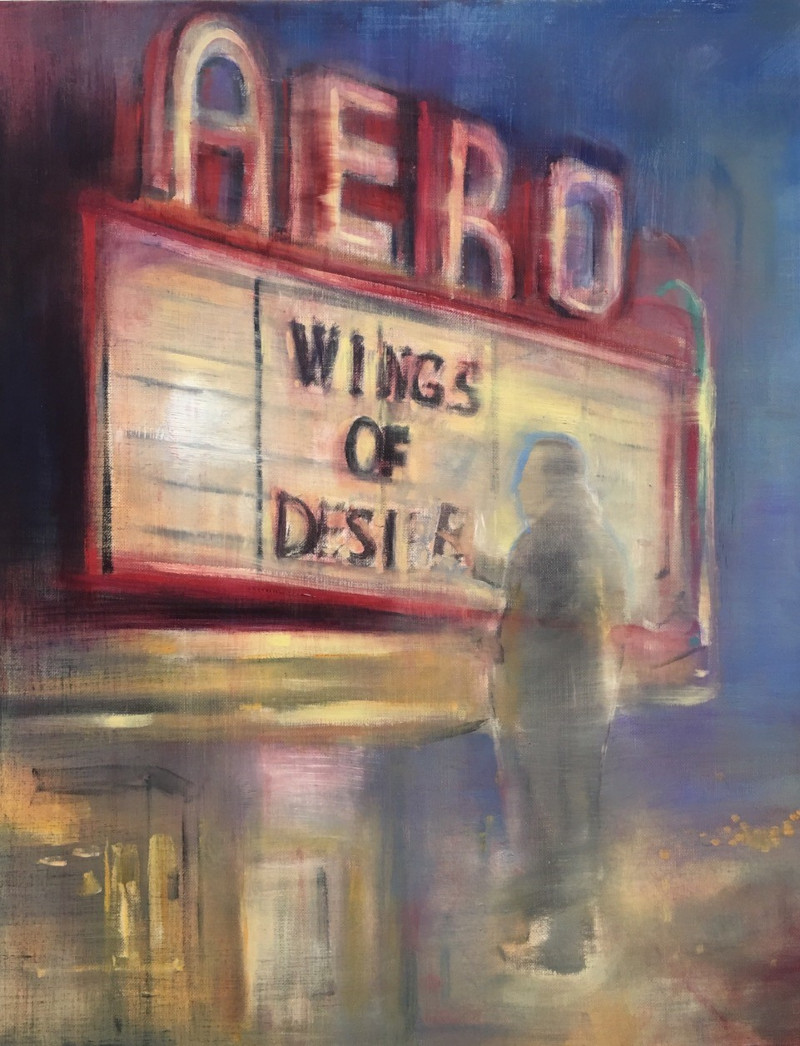
In the past few years, a magnificent bookstore in Maastricht, The Netherlands has inspired a group of oil paintings and works on paper.
I exhibited my latest painting in this series, Carpe Librum (Maastricht), at The Other Art Fair at Barker Hangar in September 2021. I found that writers in particular are intrigued by this homage to the world of books and learning.
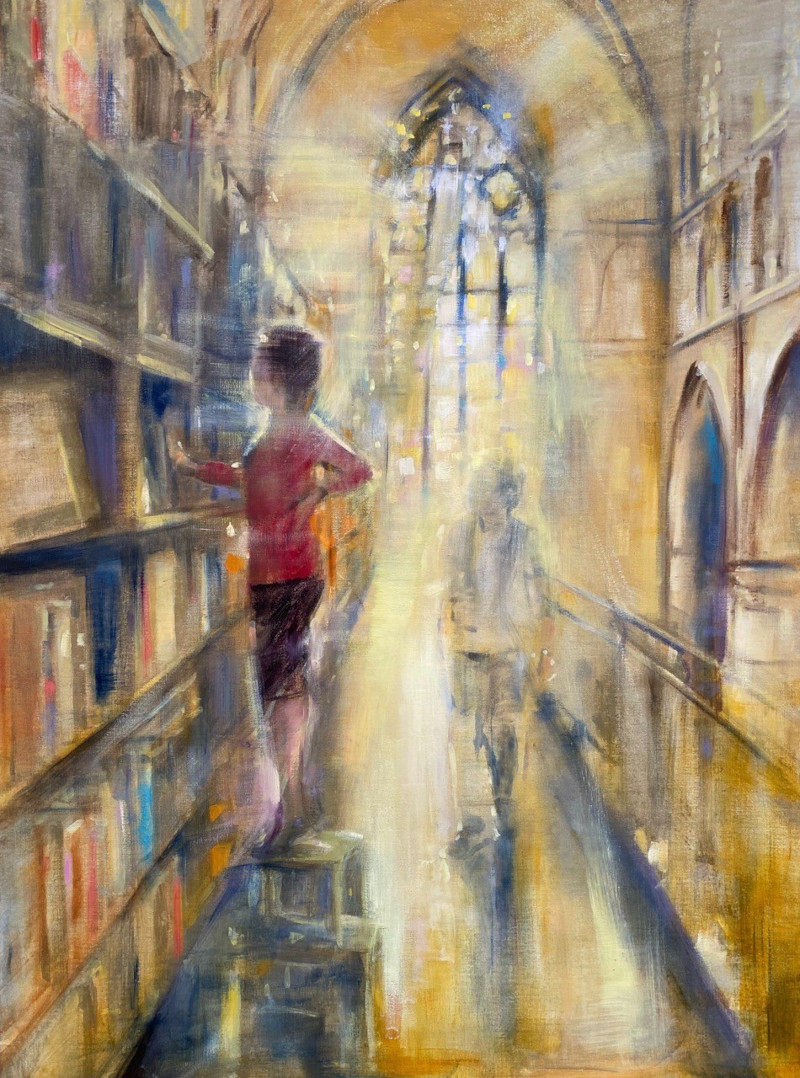
And sometimes, my paintings will inspire a writer directly. Recently, I was approached by an Athens-based publisher to see if I would be interested in having my painting Steps of
Time used as a cover for Efi Georgaki's novel Cellophane published by Syrtari Press in September 2020. I am thrilled that my painting is on the cover of Georgaki’s book.
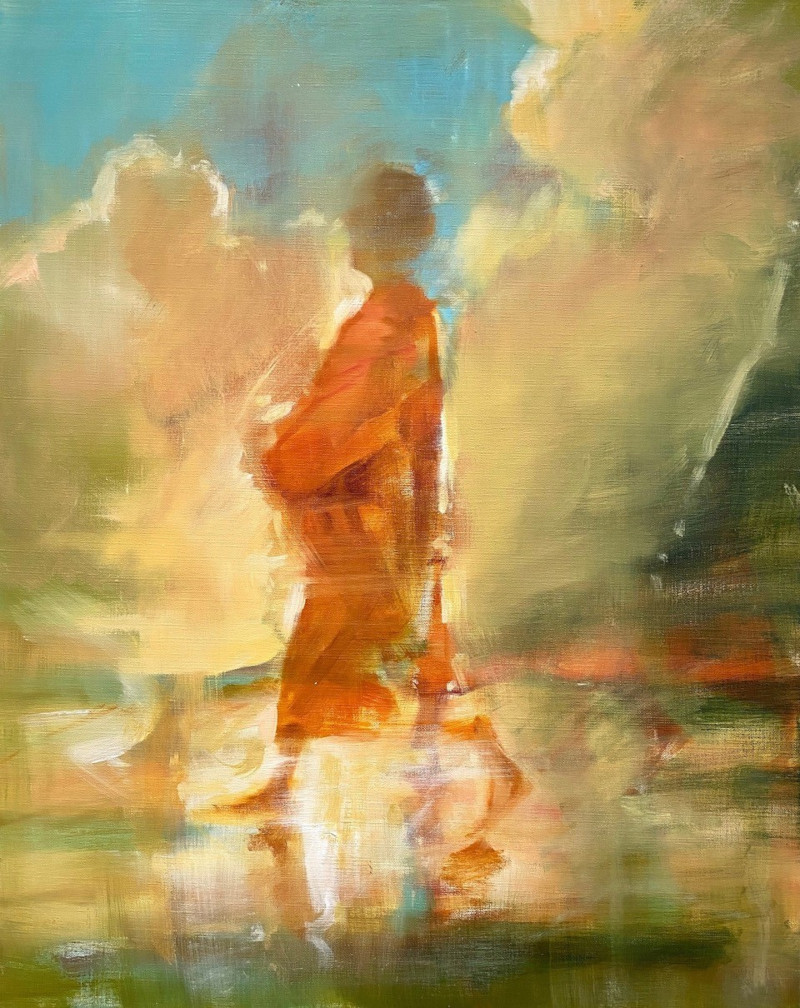
You state that you are deeply inspired by walking in cities. Do you see yourself as a modern flaneur who takes inspiration from the streets and puts it into paintings?
I embrace the title of Modern Flâneur. When traveling, I like to get up at dawn and catch the early morning light on the streets. These luminous mornings seem to create memories that never fade.
I had my first espresso in Georgetown in DC when I took classes at the Corcoran School of Art. We ordered at the counter and then I sat with my brother Kent at an outdoor table and watched,
as the late morning light gilded the district’s streets. The hiss and purr of the espresso machine coupled with the aroma of roasted coffee and the memory of slanted light captured me.
I continue to search for moments like these, as I wander through cities. I consider these moments of inspiration small epiphanies that help me focus on the wealth of beauty in the world.
My gouache and monotype painting on paper, The Secret Chord (Leonard Cohen Over Montréal), illustrates how my wanderings across the globe inspire my art. On that trip to Montréal,
I traversed the city in search of Leonard Cohen. From the old harbor to Mount Royal, traces of the poet and singer can be found by those who know where to look. Leonard's music and
poetry provide clues about his life in Montréal and also offer hope to a darkened world. I put the finishing touches on this painting of Leonard Cohen hanging over the city of Montréal like a secular saint of music on a September 21st - the anniversary of Leonard's birth.
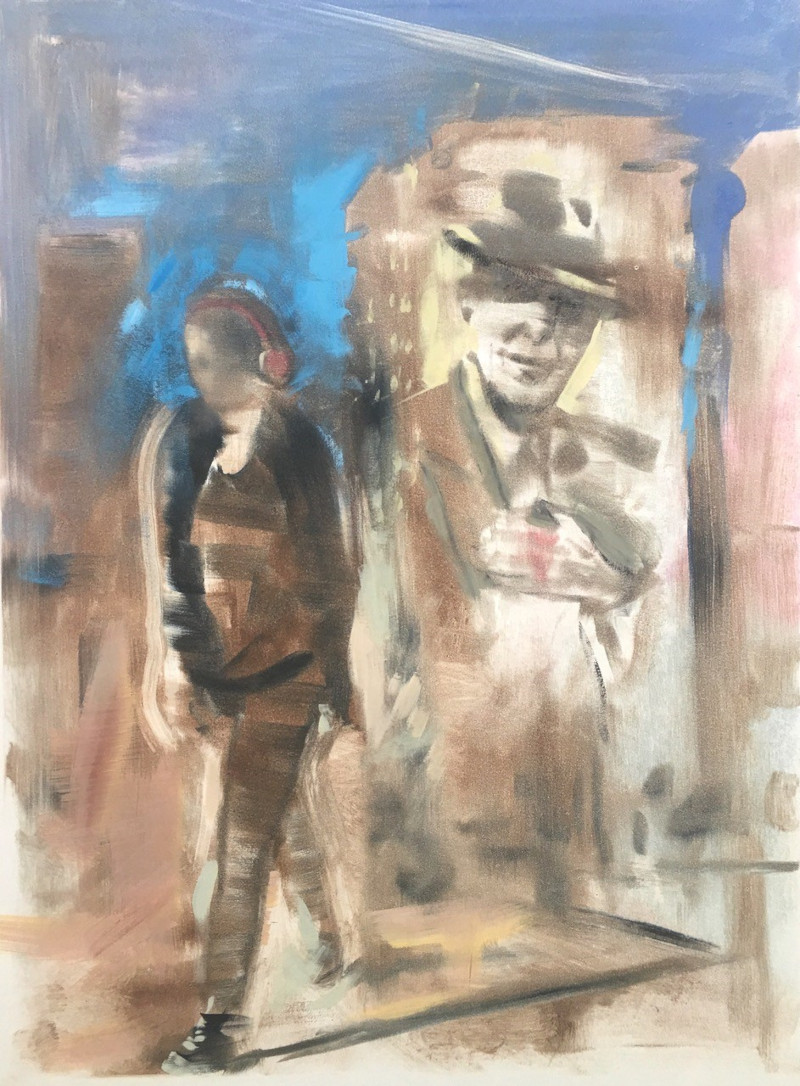
We discovered your art at The Other Art Fair. What do you appreciate about exhibiting in galleries and at art shows versus creating unique client-specific pieces? Which challenges do you face for both processes?
Recently at The Other Art Fair at the Barker Hangar in Santa Monica, Troy Thompsen, co-founder of TKO Art, stopped at my booth and without looking up at my name on the sign, said to his business partner Heather Katz that the paintings in front of him looked like the work of Gregg Chadwick. Connecting with art dealers, art consultants, collectors, art writers, social media followers, fellow artists, and friends, is one of the great benefits of art fairs and gallery exhibitions. The opportunity to exhibit my latest work in a professional setting has led to many sales and opportunities over the years. Having a deadline on the calendar does wonders to spur on my studio practice. I love to paint up until the last possible moment, never knowing what might emerge out of a burst of creativity. Often a new artwork that is not quite finished for an art fair or gallery opening will become the keynote painting of a future exhibition.
I also enjoy the process of creating unique client-specific pieces. During the pandemic, I have painted a number of commissioned artworks. A fruitful artistic dialogue or collaboration develops as I turn the collector’s ideas into a new painting.
Can you share some advice for individuals who feel the desire to create meaning through images but struggle how to start?
How do you live a life that enables you to create meaning through images?
For me, that means waking up each morning with the aim of creating something new each day that reflects the beauty and struggles found in life.
Start, with an uncensored sketch on paper or canvas. Ask yourself - how do you feel? And then reach deep into your memories for images or things
that reflect your feelings. After you draw these memories, lay the pages out and see if they bring to mind archetypes or influences. Feel free to
connect your drawings as if they were panels in a graphic novel. I am often surprised by the stories that my images begin to create.
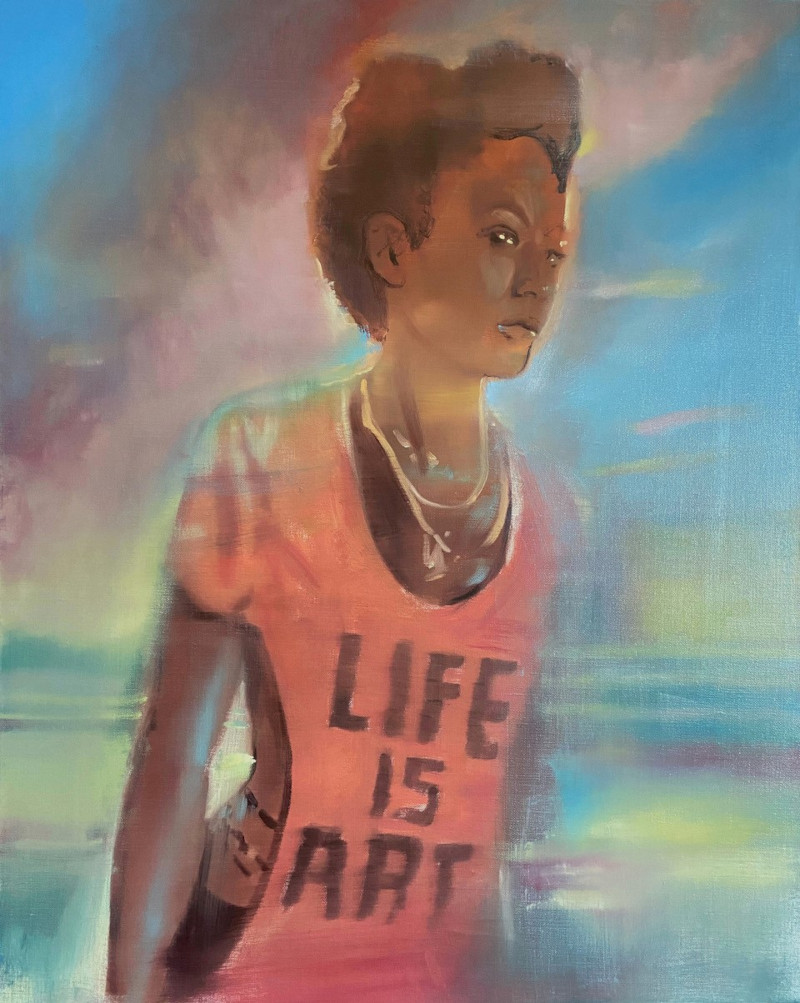
What is the main purpose of your artistic profession?
In my art practice, I aim to create paintings that illuminate the time that we live in, that engage and celebrate the beautiful diversity of humanity, and inspire the viewer to enter into my artworks and find new stories and new ideas.
|
|

